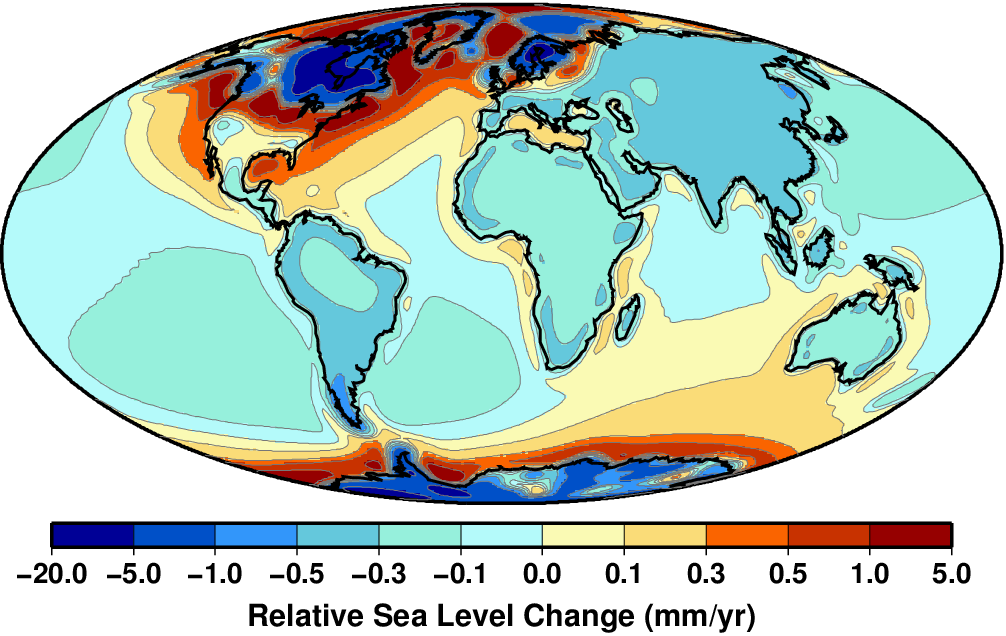|
Water Planet An Umbrella Project at the Centre for Earth Evolution and Dynamics |

|
Research Topics: Mantle Dynamics | Volcanism | Surface Deformation | Seafloor Geology | Planets |
Water and Surface Deformation
|
Water on Earth’s surface is stored primarily as seawater in the ocean basins and as ice and groundwater on the continents. Changes to Earth’s climate cause water to move between these storage reservoirs, resulting in adjustments to Earth’s hydrological load. These changes can deform the Earth’s solid surface, deflect Earth’s gravitational field, and perturb Earth’s rotation axis. On longer timescales, geologic and geophysical processes can alter the shapes of ocean basins and continents, influencing sea level and affecting climate. Study of water movements across recent history and distant geologic time can help us to understand the deformation processes occurring within the Earth.
Elastic Deformation: Interaction with Modern Climate Change On the shortest timescales, the solid earth deforms instantaneously with an elastic response to an imposed load (Fig. 1). For example, the mass loss from a melting ice sheet causes ground uplift near the ice sheet and depresses the ocean basins, which gain mass. The sea surface drops near the area of deglaciation because the diminished ice sheet gravitationally attracts less seawater (Conrad and Hager, 1997). Relative to the ground surface, sea level falls near melting ice but rises faster than average over the rest of the ocean (Fig. 2). It is important to understand these spatial variations in sea level, also known as sea level “fingerprints”, because they significantly influence the impact of future sea level change on coastal communities (Mitrovica et al., 2001).
Viscous Deformation: Interaction with Ice Age Deglaciation Following glacial unloading, the earth deforms viscously on timescales of thousands to tens of thousands of years as the mantle flows back into a region previously depressed by the weight of glacial ice (Fig. 3). This deformation uplifts the region near the former ice sheet (locally causing relative sea level drop) and depresses the surrounding peripheral forebulge (where relative sea level rises). Today, these deformations are occurring as a result of melting that has happened since the last ice age. The resulting ground deformation causes relative sea level change that can be predicted by models of mantle deformation (Fig. 4) and can be observed in crustal motions today. This glacial isostatic adjustment (GIA), also known as postglacial rebound, provides a critical constraint on mantle viscosity (e.g., Mitrovica, 1996). Understanding the patterns and rates of GIA deformation today is critical for understanding the deformations associated with modern-day sea level change.
Geologic Deformation: Interaction with Sea Level Throughout Earth History On timescales of millions of years and longer, solid earth processes associated with plate tectonics and mantle convection (Water & Mantle Dynamics) interact with water in the ocean basins to determine sea level (Fig. 5). Sea level rises when the “container” volume of the ocean basins decreases due to: (a) ridge expansion associated with faster spreading, (b) expansion of continental area, (c) an increase in the volume of submarine volcanoes (seamounts or large igneous provinces), (d) grown of sediment cover on the seafloor, and (e) net dynamic uplift of the seafloor by mantle flow. This last process (dynamic topography) may also induce lateral variations in sea level change by deflecting the ground surface locally. Sea level also rises if water exchange with the deep mantle becomes imbalanced (either via increased volcanic outgassing or diminished loss via subduction). Because sea level is one of the primary observables in the geologic record, understanding the ways that the solid earth interacts with sea level can place important constraints on a variety of geologic processes.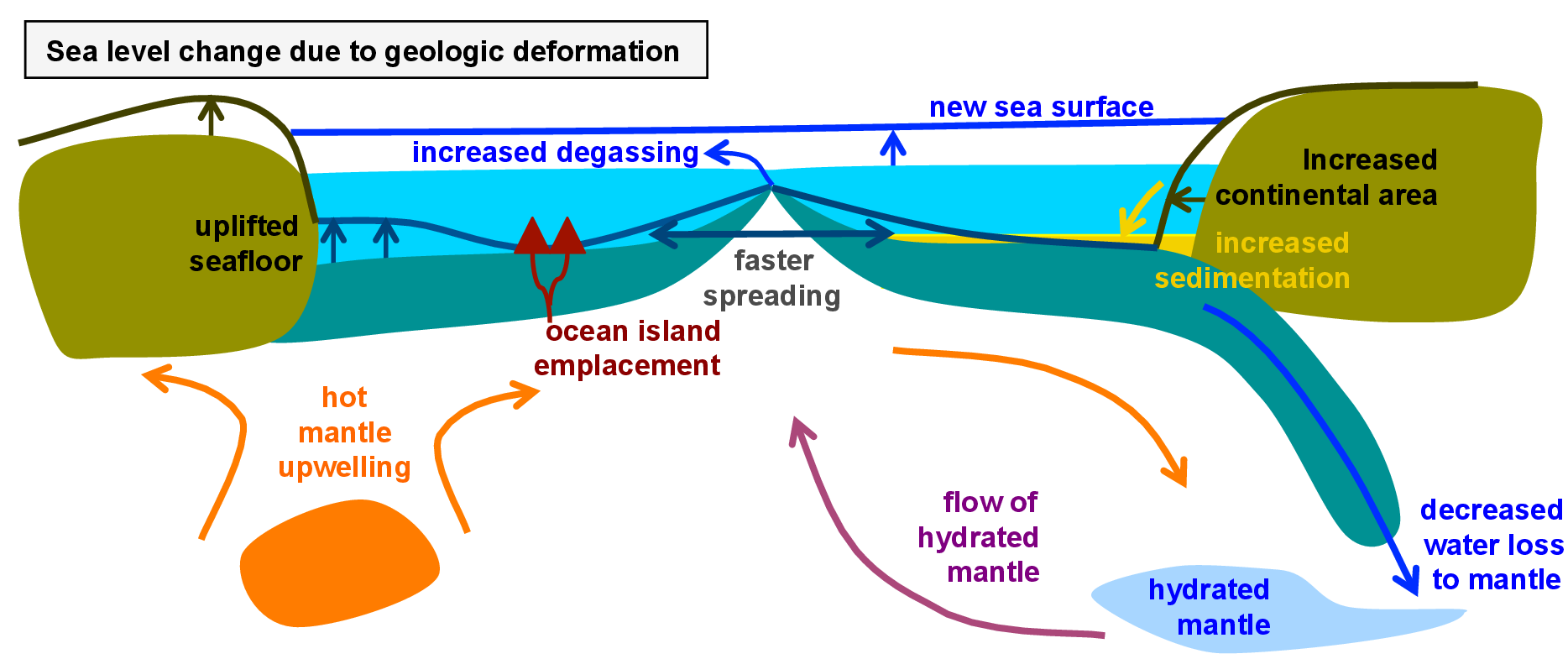 Figure 5. A sketch showing the major geologic processes that can elevate global sea level (or depress it when acting oppositely). Although these processes drive sea level change that is relatively slow (at most only a few meters per million years, or 10-3 mm/yr) compared to present-day rates (a few mm/yr), they can operate continuously over millions of years to produce hundreds of meters of sea level change. (Figure after Conrad, 2013)
References Conrad, C. P. (2013), The solid Earth’s influence on sea level, Geological Society of America Bulletin, 125(7-8), 1027-1052, doi:10.1130/b30764.1.Conrad, C. P., and B. H. Hager (1997), Spatial variations in the rate of sea level rise caused by the present-day melting of glaciers and ice sheets, Geophysical Research Letters, 24(12), 1503-1506, doi:10.1029/97gl01338. Jacob, T., J. Wahr, W. T. Pfeffer, and S. Swenson (2012), Recent contributions of glaciers and ice caps to sea level rise, Nature, 482, 514-518, doi:10.1038/nature10847. Mitrovica, J. X. (1996), Haskell 1935 revisited, Journal of Geophysical Research-Solid Earth, 101(B1), 555-569, doi:10.1029/95jb03208. Mitrovica, J. X., M. E. Tamisiea, J. L. Davis, and G. A. Milne (2001), Recent mass balance of polar ice sheets inferred from patterns of global sea-level change, Nature, 409(6823), 1026-1029, doi:10.1038/35059054. Paulson, A., S. J. Zhong, and J. Wahr (2007), Inference of mantle viscosity from GRACE and relative sea level data, Geophysical Journal International, 171(2), 497-508, doi:10.1111/j.1365-246X.2007.03556.x. Peltier, W. R. (2004), Global glacial isostasy and the surface of the ice-age earth: The ICE-5G (VM2) model and GRACE, Annu. Rev. Earth Planet. Sci., 32(1), 111-149, doi:10.1146/annurev.earth.32.082503.144359.
|

|
 |

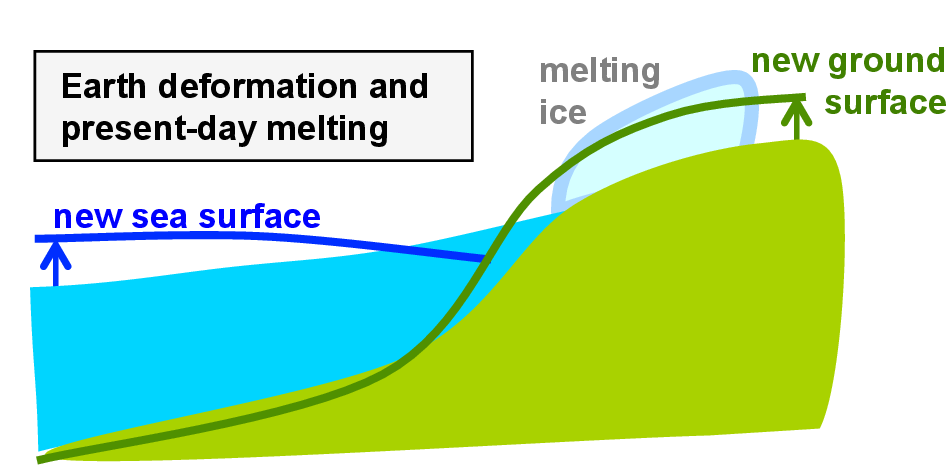 Figure 1. As ice melts, mass is moved from the continental
areas into the oceans. The mass loss on land causes the rocks
beneath the melting ice to expand, uplifting the ground
surface. At the same time, the gravitational attraction of
seawater to the ice sheet diminishes, which causes the sea
surface to fall near the ice sheet. The combination of these
effects causes slower (or even negative) sea level rise near
major sources of meltwater. (Figure after Conrad, 2013)
Figure 1. As ice melts, mass is moved from the continental
areas into the oceans. The mass loss on land causes the rocks
beneath the melting ice to expand, uplifting the ground
surface. At the same time, the gravitational attraction of
seawater to the ice sheet diminishes, which causes the sea
surface to fall near the ice sheet. The combination of these
effects causes slower (or even negative) sea level rise near
major sources of meltwater. (Figure after Conrad, 2013)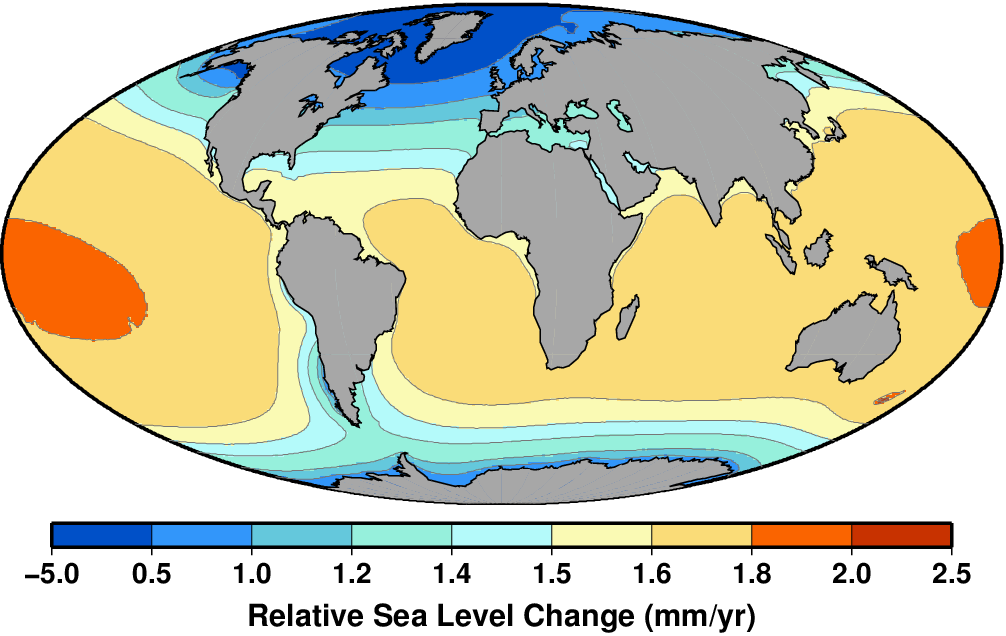
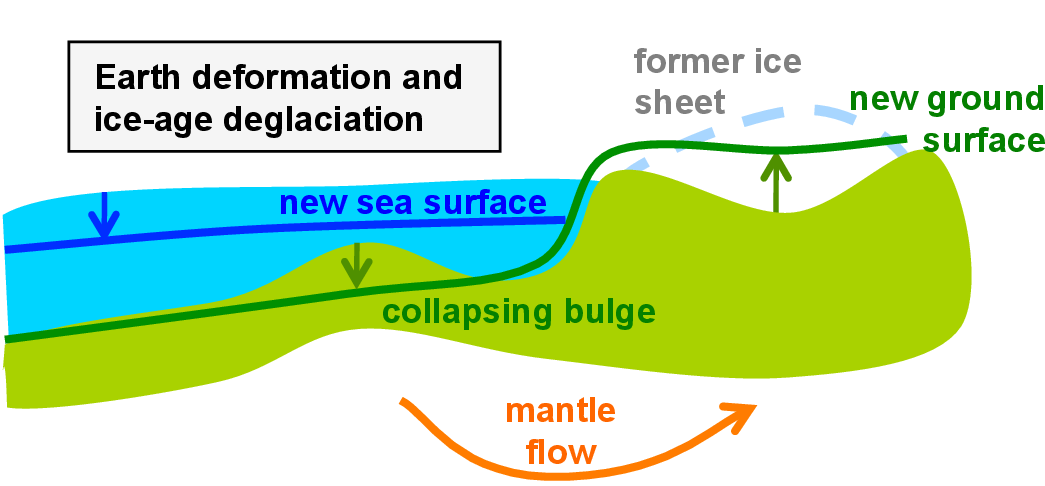 Figure 3. The weight of a major ice sheet pushes the mantle away beneath the ice, depressing the ground surface and creating a peripheral bulge that surrounds the ice sheet. If the ice sheet melts, the mantle flows back into the space beneath the former ice sheet (shown here), which uplifts the deglaciated region while the peripheral bulge collapses. This glacial isostatic adjustment (GIA) causes patterns of sea level change (Fig. 4) that persist for thousands of years. (Figure after Conrad, 2013)
Figure 3. The weight of a major ice sheet pushes the mantle away beneath the ice, depressing the ground surface and creating a peripheral bulge that surrounds the ice sheet. If the ice sheet melts, the mantle flows back into the space beneath the former ice sheet (shown here), which uplifts the deglaciated region while the peripheral bulge collapses. This glacial isostatic adjustment (GIA) causes patterns of sea level change (Fig. 4) that persist for thousands of years. (Figure after Conrad, 2013)